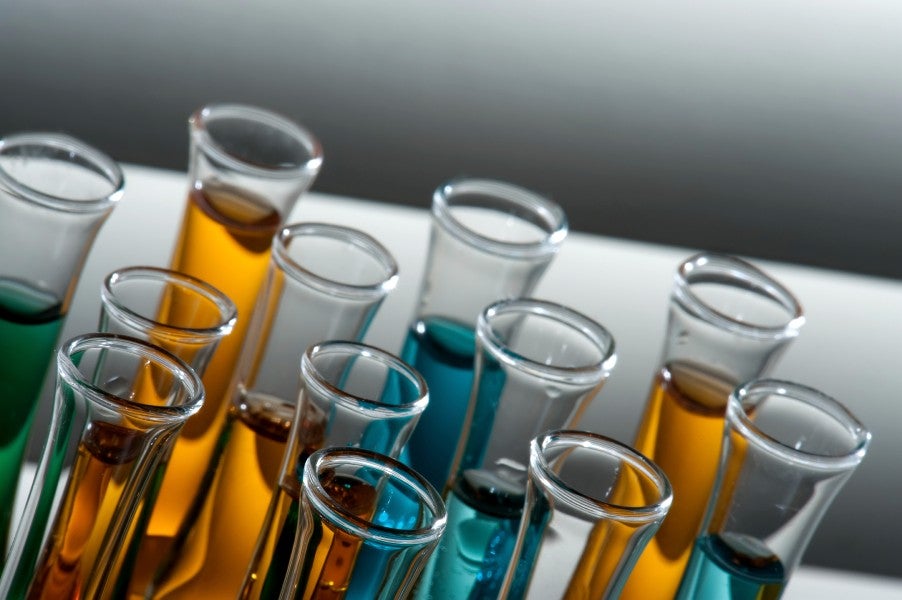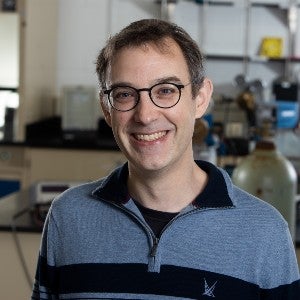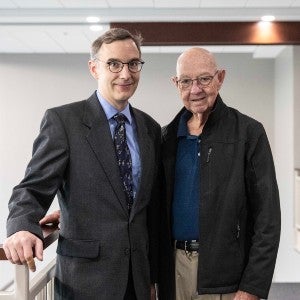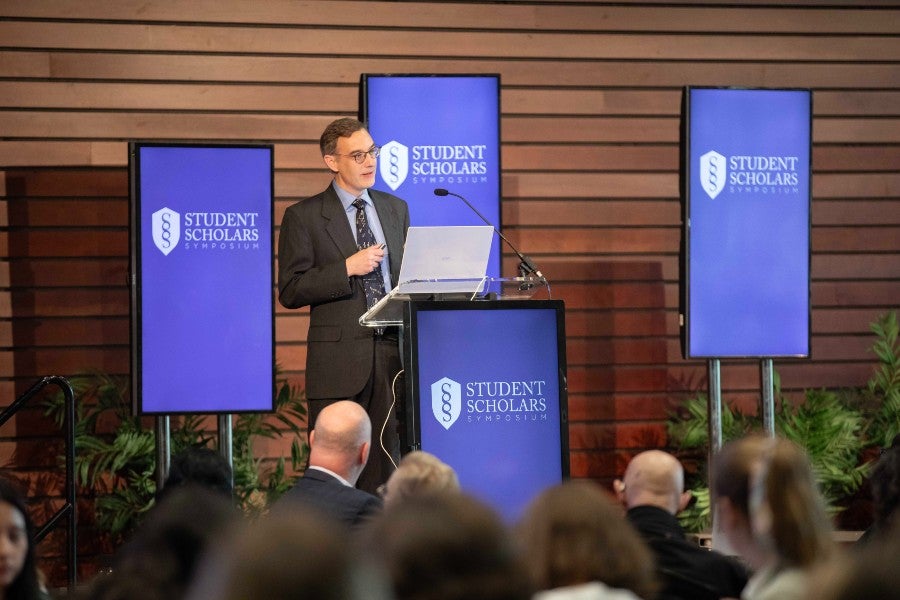Lauded theoretical chemist and alumnus speaks at 2024 Student Scholars Symposium
Paul Ayers, award-winning research scientist, found his calling and his research skills in Lipscomb’s science classrooms.
From staff reports |

Parts of this story were pulled from a 2015 story by Kim Chaudoin.

There are few people who could better represent the epitome of a Lipscomb research scientist than the Canada Research Chair for Theoretical Chemistry at McMaster University, Paul Ayers (BS ’96).
Ayers heard his calling at Lipscomb. He built his intellectual and professional skills and his research resume at Lipscomb. He discovered his way to make a difference in the world at Lipscomb.
And this month he came back to Lipscomb to share his career experience with the next generation of Lipscomb researchers at a free lecture at the Student Scholars Symposium.
“Despite the fact—or maybe because—my parents were chemistry professors, I came to science relatively late,” said Ayers. “It was late in my senior year of high school that I decided to study physics,” the first of three majors he held upon graduating from Lipscomb.
But that late start has not held him back in his eventual chosen field of theoretical chemistry.
In addition to his work at McMaster University in Canada as professor of chemistry and chemical biology, and his postdoctoral fellowship at Duke University, he has also published 370 papers and book chapters, given more than 300 invited lectures and has won a plethora of awards including several of the top international awards in the field: the Dirac Medal, the annual medal of the International Academy of Quantum Molecular Science, the Rutherford Medal and a fellowship in the Royal Society of Chemistry.
When I impetuously decided to try to complete a chemistry major in just two years, Dr. Bill Tallon made it happen... I was asked to supervise a lab for Dr. Paul Langford. That played a major role in my pursuit of an academic career. Lipscomb was the nest where my scientific life fledged. — Paul Ayers
“Dr. Ayers is extremely well-known and well-respected in the field,” said Lipscomb’s retired chair of chemistry Kent Clinger, who taught Ayers during his years at Lipscomb. “It is amazing how many awards he has won. That puts him in rare company and indicates to me that it wouldn’t be beyond the realm of possibility for Dr. Ayers to be in the conversation for a Nobel Prize at some point.”
Theoretical chemistry seeks to provide conceptual, mathematical and computational tools for describing chemical and physical reactions. By being able to predict chemical phenomena, scientists like Ayers could help open the door for new medical therapies, as well as other technologies, to be developed much faster, less expensively and more safely.
Ayers leads one of the largest theoretical groups in Canada. His wide-ranging contributions to the field have included purely mathematical concepts, unique algorithms and leading-edge computer programming. His research focus is contributing to developing new machine-learning methods for predicting the properties of molecules and materials, deciphering complex chemical reactions and designing new drugs.

Paul Ayers (left) with his father Paul Ayers Sr., a 1960 Lipscomb alumnus and chemistry teacher.
The North Carolina native applied to Lipscomb intending to be a writer, but changed his mind before arriving, deciding to major in physics. “My father (Paul Ayers Sr. (’60)) was a classmate of Dr. (Fletcher) Srygley in physics… Lipscomb impressed me with the quality of its science offerings, so I made the decision to go there,” Ayers said.
“Soon I realized that I enjoyed the mathematical aspects of physics more than applications. So I added mathematics as a second major,” he said.
After his second year at Lipscomb, a colleague of his parents at East Carolina University hired him to do summer research in theoretical chemistry. “This was a transformative experience,” he said. “I learned that I could use the tools I love—mathematics and physics—to study problems I find interesting such as how and why chemical reactions happen. So I added chemistry as a third major.”
After two more years of diligent study and one more summer of research, he graduated with a triple-major in mathematics, physics and chemistry (and a perfect 4.0 GPA).
“I also took nearly 20 elective courses in philosophy, religion and creative writing, reflecting broad interests that I maintain to this day,” he said.
During his days at Lipscomb, former physics professor Everett Hunt “took me under his wing,” allowing him to take his first-year physics course as an independent study, and retired professor of chemistry Bill Tallon piqued his interest in chemistry.
“When I impetuously decided to try to complete a chemistry major in just two years, (Dr. Tallon) made it happen. In my third year, I was asked to supervise a lab for Dr. Paul Langford. That played a major role in my pursuit of an academic career. Lipscomb was the nest where my scientific life fledged.”
The modern methods... are really just the modern manifestations of the classical mathematical statistics I learned from Dr. Doy Holman at Lipscomb. — Paul Ayers
And the fledgling interest has grown over a lifetime into a passion.
“What I love about my job is that it is something new every day,” said Ayers. “Theorists strive to understand why things happen. Each day brings new challenges: a new facet of a problem to contemplate, a new perspective to consider. It’s an ideal field for idea junkies like me.”
Based partly on generous fellowship support from the University of North Carolina, Ayers opted to pursue a Ph.D. in chemistry under the direction of Professor Robert Parr. “Parr’s approach to research—using mathematics and physics to study fundamental problems in chemistry and chemical reactivity—appealed to me, and soon I was ‘addicted’ to research,” he said.
Upon receiving his Ph.D. in 2001, Ayers joined the research group of Dr. Weitao Yang in the chemistry department at Duke University, where he held a National Institutes of Health Postdoctoral Research Fellowship. While Yang’s research also uses physics and mathematics at a high level, his research focuses on developing new computational methods for biochemistry and materials science, said Ayers.
“With Prof. Yang, I learned more about computational methods and the ways theoretical chemistry can be used to address practical problems,” he said. “My postdoctoral experience completed my transformation from mathematical physics to my current research niche, which lies somewhere between Professor Parr (whose research was typically more abstract) and Professor Yang (whose research is often more applied).”

Paul Ayers speaking at the 2024 Student Scholars Symposium.
After a year at Duke, Ayers left to become an assistant professor of chemistry at McMaster University. Since then, he has focused on establishing his career as a teacher, mentor, colleague and researcher.
Ayer’s work in the field has the potential for significant practical application. For example, determining how a single molecule could behave like a tiny magnet could lead to advances in quantum computing and information storage as well as refrigeration and air conditioning systems that are more environmentally friendly.
The other main thrust of Ayers’ research is to develop new chemical concepts and principles.
“Most of the concepts, principles and rules that chemists use predate the discovery of quantum mechanics. Unfortunately, most of these concepts and principles don’t actually have any quantum-mechanical foundation; they are purely phenomenological,” he said. “We try to find mathematical justifications for existing concepts and principles and try to develop new ones that are firmly grounded in quantum mechanics. We then use these principles to make predictions, often using modern statistical methods.”
The modern methods incorporate buzzwords like “big data” and “machine learning,” said Ayers, “but they are really just the modern manifestations of the classical mathematical statistics I learned from Dr. Doy Holman at Lipscomb.”
Theorists strive to understand why things happen. Each day brings new challenges: a new facet of a problem to contemplate, a new perspective to consider. It’s an ideal field for idea junkies like me. — Paul Ayers
Perhaps the most unconventional facet of his research is its emphasis on developing tools for understanding, at a qualitative level, why chemical reactions happen. For example, he has used the mathematical frameworks provided by information theory and density-functional theory to bridge the gap between physical principles and chemical concepts like atomic populations and the hard/soft acid/base reactivity rule.
At a quantitative level, he develops accurate and efficient quantum chemistry methods. His recent work along those lines includes the use of wavefunction forms of exactly solvable models to study chemical systems. These new wavefunction forms generalize some traditional approaches in quantum chemistry (notably antisymmetric products of geminals) but, unlike traditional approaches, remain effective when electrons are strongly correlated.
He is one of the four co-founders of, and the de facto lead scientist for, the QC-Devs software consortium, an international group of 75 software developers who develop free and open source software for the computational sciences, emphasizing chemistry.
He also co-founded and leads QC-Edu, which develops online training materials and presents scientific training workshops on theoretical chemistry, computer programming and software development at institutions around the world.